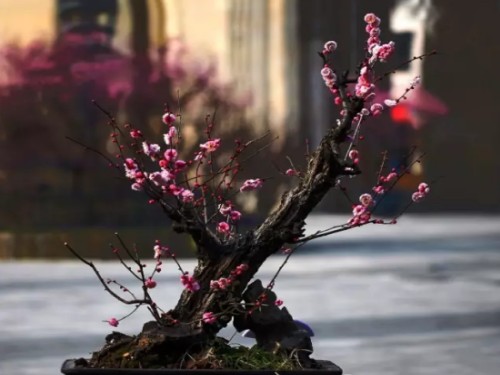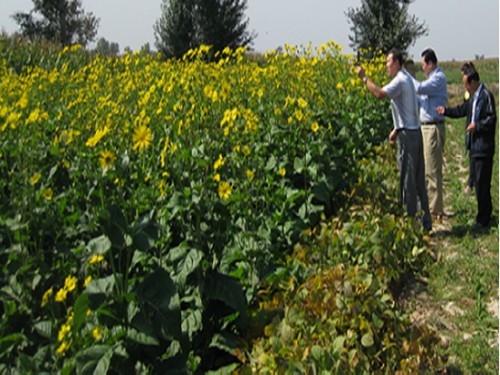Cultivation techniques of Ganoderma lucidum bonsai
Ganoderma lucidum bonsai is a kind of stereotyped handicraft made from mature dried Ganoderma lucidum in recent years. The use of foam plastic greenhouse technology will be in the growth stage of Ganoderma lucidum live pot to make live Ganoderma lucidum bonsai, like potted flowers, can be seen Ganoderma lucidum seedling stalk elongation. The following editor introduces the cultivation techniques of Ganoderma lucidum bonsai.
Ganoderma lucidum has been a rich and auspicious thing since ancient times, symbolizing good luck, auspiciousness and longevity, but also reflects people's desire for auspiciousness, wealth, peace and happiness. Ganoderma lucidum is not suitable for planting in the north, but the effect of bonsai cultivation in greenhouse is very good. It is precisely because of the beautiful meaning of Ganoderma lucidum that it has become the best choice for many people to collect and give gifts. Ganoderma lucidum bonsai not only has good ornamental value, but also has certain medicinal value, and the market prospect is good.

1. Cultivation substrate
Ganoderma lucidum belongs to wood-rot fungi and is suitable for growing on substrates such as sawdust and cottonseed hulls. The culture medium is composed of 78% sawdust or cottonseed hull, 20% wheat bran, 1% gypsum powder, 1% sugar, and 60% moisture 62% natural pH.
2. Cultivation season
Ganoderma lucidum belongs to constant temperature, medium and high temperature fungi, and the seedling temperature and temperature of Ganoderma lucidum are both 22 ℃ and 28 min. Therefore, it is better to produce Ganoderma lucidum in late spring and early summer in southern China. It can be inoculated after mid-January, start to produce Ganoderma lucidum after mid-March, and go on the pot for sale in mid-April. Ganoderma lucidum can be inoculated in early August, in mid-September, and ready for sale in late September. This is conducive to the two golden cycles of the market.
3. Greenhouse construction
The greenhouse is rebuilt from an ordinary plastic greenhouse. The outer layer is covered with sunshade net to achieve the light intensity of seven yin and three yang; the middle layer is 0.5 cm thick foam plastic plate, which has the effect of heat preservation; the inner layer is non-toxic plastic film, which can enhance the moisturizing ability. Both wooden bar frame doors are sealed with plastic film in order to adjust the amount of ventilation and light transmission.
4. Select varieties
According to the different characteristics of different varieties of Ganoderma lucidum, different types and colors of Ganoderma lucidum can be selected to make live Ganoderma lucidum. It is generally required that the varieties with more branches, longer stalk, small cover, slow growth and few spores are better. For example, Yuanzhi 6, Yuanzhi 9, Peking University, Xinzhou, Zizhi and so on.
Ganoderma lucidum is a saprophytic fungus, which is suitable for growing on dead wood. Artificial cultivation can be cultivated by section wood cultivation, sawing wood cultivation or other substitute cultivation, such as bottle cultivation, pot cultivation, plastic bag cultivation, fungus brick cultivation, section wood cultivation and so on. The cultivation time is determined according to the natural temperature, which is generally suitable from April to September, and the cultivation of Duan Mu is very suitable, because it can grow for several years and can be cultivated at any time. Bottle planting, pot planting and bag planting are relatively fast, from cultivation to fruiting body growth only takes about 20 days, and a growth cycle can be completed in about 40 days.
1. Preparation of raw materials
Cottonseed hull 65%, calcium superphosphate 3%, gypsum 2%, water content 65%; or sawdust 78%, wheat bran 20%, white sugar 1%, gypsum 1%, water content 65%.
2. Sterilization and inoculation
After mixing the above raw materials well, put them into a basin with a thickness of 3 to 4 inches, flatten the surface of the medium and seal it with plastic film for sterilization. Sterilization method: high pressure sterilization, which can be kept for 1 hour when the pressure is 115 pounds. The soil method was sterilized and kept for 6 hours from boiling water for 8 hours, and then inoculated after cooling.
Disinfection was carried out in the inoculation box inoculation room. The mixture of formaldehyde 10 mL/m2 and potassium permanganate 6g/m2 was gasified and inoculated after 30 min. When inoculating, remove the surface layer of the raw materials, and then connect the cultured bacteria to the sterilized basin, which is about the size of fingers, and each basin surface can be connected with 4-5 holes or replanting bacteria, and then seal the mouth of the basin and put it in the culture room for culture. Keep the temperature at 25: 28 ℃ and the relative humidity at 75% 80%. Pay attention to ventilation and keep the environment clean. After 25-30 days of culture, the hyphae could grow all over the whole basin. If a fruiting body occurs, the plastic film should be removed immediately. When the mycelium grows to 1/2, the buds will appear on the surface of the culture medium, and the buds will expand gradually. At this time, the management of ventilation, light, heat preservation and moisturizing should be strengthened to grow and mature in about a month.
3. Cultivation modeling
Ganoderma lucidum cover has round, kidney-shaped, fan-shaped and other shapes; there are annular, cloud-shaped, ribbed and radial wrinkles; the stalk is slender, lateral, partial or branched; manual processing can cultivate a variety of shapes of Ganoderma lucidum. What is more valuable is that after the fruit body is ripe, it has a hard texture, a lacquer-like natural luster, and is a very rare material for bonsai technology. According to the biological characteristics of Ganoderma lucidum, the effect of growth inhibition, promotion and modeling can be achieved by changing the conditions of light, temperature, water, gas and so on.
The main results are as follows: (1) to control the formation of stalk and cap, the culture basin which has just formed fruiting body primordium is placed in a large glass tank with suitable temperature, humidity and light. A glass plate with 1 / 2 cm ventilation on the cylinder head makes it poorly ventilated. At this time, the fruiting body primordium in the cylinder only elongates the fungal stalk but does not form the bacterial lid. When the fungal stalk grows to a certain length, the culture pot is taken out of the cylinder and placed outside the cylinder. Because of good ventilation, the newly elongated fungal stalk will soon form a bacterial cap.
(2) in the culture of double-layer bacterial cap, Ganoderma lucidum, which has formed the bacterial cap but has not stopped growing, will be further cultured in a human glass tank, and a proliferative layer will appear under the bacterial cap, and cover part of the bacterial pore, so that the bacterial cap will increase and thicken. If this state of poor ventilation is maintained, the secondary stalk will grow at the edge of the proliferative layer and continue to elongate. If it is removed from the glass tank and good ventilation conditions are restored, the secondary stalk will soon grow into a lid, forming a double-layer cap of Ganoderma lucidum.
(3) according to the strong phototropism of Ganoderma lucidum, in the fruiting body growth stage, shading on four sides can make the stalk and cap grow vertically. If unilateral light is used, the stalk and cover can grow in the direction of light. In addition, the degree of exposure to light intensity is different, the color of the fruiting body is also different.
(4) the fruiting bodies of different shapes and sizes can be cultivated by controlling the size of blossoms and selecting containers with different caliber. If you use a small-caliber bottle as a container, you can form a solitary Ganoderma lucidum with a long stalk, and with a small flowerpot as a container, you will grow a ganoderma lucidum with multiple stalks. If you use a plastic bag as a container, you can grow a large ganoderma lucidum with a large stalk and a thick stalk.
(5) the deformed fruiting body can be deformed by ultraviolet radiation. Wrapped with plastic paper, the growing stalk can be bent, thickened, or partial scarred cap.
4. Bonsai configuration
The cultivated Ganoderma lucidum can be made into Ganoderma lucidum bonsai with different shapes and colorful bonsai by artificial refurbishment and embellishment with rocks, tree stumps, bamboo whips, flowers and plants.
Warm Tips:
1. Ganoderma lucidum does not need to be watered or sprayed before it begins to grow leaves. There are enough nutrients and water for Ganoderma lucidum to grow in the bag.
2. Put the bag in a dark place to avoid direct sunlight and exposure. Only weak scattered light is needed.
3. start spraying water when slightly growing leaves, sooner or later, spray wet leaves, do not spray water on rainy and cloudy days, do not drench Rain Water.
Time: 2019-05-24 Click:
- Prev

Cultivation techniques of red plum bonsai
Red plum is a kind of flower, a kind of pure and beautiful flower. Cold earth, it tenaciously blossoms beautiful, pure and thin flowers, some white through red, some white and elegant, and some pink such as Xia petals moist and transparent, like ice carvings, if jade. It is varied, brilliant and fragrant, fluttering with the wind
- Next

Planting technique of Pinus elliottii
Cuihu Wetland Park has a beautiful flower whose posture is similar to that of chrysanthemum. Yellow flowers bloom in pieces, making people feel cheerful. Its name is Pine and Vanilla with leaves. Rosin herb, alias chrysanthemum grass, cup grass, French champagne, etc., is a perennial herb of the genus Compositae.
Related
- Fuxing push coffee new agricultural production and marketing class: lack of small-scale processing plants
- Jujube rice field leisure farm deep ploughing Yilan for five years to create a space for organic food and play
- Nongyu Farm-A trial of organic papaya for brave women with advanced technology
- Four points for attention in the prevention and control of diseases and insect pests of edible fungi
- How to add nutrient solution to Edible Fungi
- Is there any good way to control edible fungus mites?
- Open Inoculation Technology of Edible Fungi
- Is there any clever way to use fertilizer for edible fungus in winter?
- What agents are used to kill the pathogens of edible fungi in the mushroom shed?
- Rapid drying of Edible Fungi

